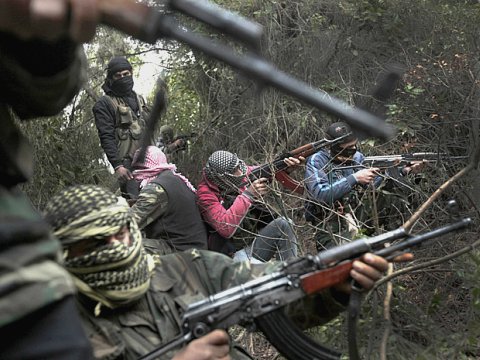Archives
AND MORE...

From Assad With Love
_____________________

American Psyche Easily Manipulated
____________________

"Kissing Assad's Ass"
_____________________

Iranian Scourge In Azerbaijan
_____________________
March 14, 2012
The Syrian Boom
"In the early days of the Iraq War, in spite of the presence of more than 200,000 coalition troops, insurgents managed to make off with more than 330 tonnes of military-grade high explosives that were used in improvised explosive devices for the next decade," according to the piece below.
Which might explain, at least in part, those truck convoys seen in satellite photos at the very beginning of the Iraq war, heading out in the middle of the night from Iraq to Damascus. Color us skeptical, but we never believed those milk delivery theories...
National Post | March 13, 2012
Syria A Chemical Weapon 'Powder Keg Ready To Explode,' Experts Fear
By Peter Goodspeed

The Free Syrian Army on Tuesday. Attacks on government weapons depots pose a threat
to chemical and biological stockpiles. Ricardo Garcia Vilanova/ AFP/Getty Images; Courtesy: nationalpost.com
While United Nations officials said Tuesday that more than 8,000 people have died in a year of political unrest in Syria, some experts fear the collapse of President Bashar al-Assad's regime may actually be worse than the threat of all-out civil war.
The sudden demise of Syria's dictator has the potential to expose the Middle East and the world to a massive new threat from chemical and biological weapons.
Syria has been stockpiling chemical and biological weapons of mass destruction since the late 1970s and is widely believed to possess one of the world's largest inventories of mustard blister agent, sarin nerve gas and possibly VX nerve agent.
"The country is a chemical powder keg ready to explode," says a report released last week by the James Martin Center for Nonproliferation Studies at the Monterey Institute of International Studies.
Hundreds of tonnes of chemical weapons, chemical warheads for medium-range, Soviet-built Scud B and C ballistic missiles, air-dropped bombs and conventional artillery shells are believed to be stored in about 50 sites around Syria.
At least four chemical weapon production facilities are located in the towns of al-Safira (12 kilometres southeast of Aleppo), Hama, Homs and Latakia, while massive munition storage depots are located at Khan Abu Shamat (northeast of Damascus) and Furqlus (just east of Homs).
"The situation in Syria is unprecedented," said Charles Blair of the Federation of American Scientists (FAS) in a recent report for the Bulletin of Atomic Scientists. "Never before has a WMD-armed country fallen into civil war."
While there was considerable concern internationally that Libyan chemical weapons and shoulder-fired anti-aircraft missiles might fall into the hands of terrorists during last year's fight to depose Colonel Muammar Gaddafi, the threat posed by Syria is exponentially higher.
"The Libyan chemical stockpile consisted of several tonnes of aging mustard gas leaking from a half-dozen containers that would have been impossible to utilize as weapons," Mr. Blair said. "Syria likely has one of the largest and most sophisticated chemical weapons programs in the world... More here
Log In »
Notable Quotables
"Mr. Netanyahu is one of the most media-savvy politicians on the planet. On Friday he appeared live via video link on 'Real Time with Bill Maher,' taking the host’s alternately sardonic and serious line of questioning with gazelle-like alacrity."
~ Anthony Grant, jourrnalist who has written for many major newspapers and worked in television at Paris and Tel Aviv, interviewing former PM Benjamin Netanyahu on Monday, at the outset of Mr. Netanyahu's new book (more here).


